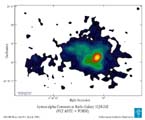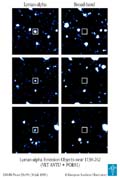Information from the European
Southern Observatory
ESO Press Release
13/99
30 July 1999
For immediate release |
|
Watching the Birth of a
Galaxy Cluster?
First Visiting Astronomers
to VLT ANTU Observe the Early Universe
When the first 8.2-m VLT Unit Telescope (ANTU)
was "handed over" to the scientists on April 1,
1999, the first "visiting astronomers" at Paranal
were George Miley and Huub
Rottgering from the Leiden Observatory (The
Netherlands) [1].
They obtained unique pictures of a distant
exploding galaxy known as 1138 -
262 . These images provide new information
about how massive galaxies and clusters of
galaxies may have formed in the early
Universe.
Formation of clusters of
galaxies
An intriguing question in modern astronomy is
how the first galaxies and groupings or clusters of galaxies emerged from
the primeval gas produced in the Big Bang. Some
theories predict that giant galaxies, often found
at the centres of rich galaxy clusters, are built
up through a step-wise process. Clumps develop in
this gas and stars condense out of those clumps to
form small galaxies. Finally these small galaxies
merge together to form larger units.
An enigmatic class of objects important for
investigating such scenarios are galaxies which
emit intense radio emission from explosions
that occur deep in their nuclei. The explosions
are believed to be triggered when material from
the merging swarm of smaller galaxies is fed into
a rotating black hole located in the central
regions. There is strong evidence that these
distant radio galaxies are
amongst the oldest and most massive galaxies in
the early Universe and are often located at the
heart of rich clusters of galaxies.
They can therefore help pinpoint regions of the
Universe in which large galaxies and clusters of
galaxies are being formed.
The radio galaxy
1138-262
The first visiting astronomers pointed ANTU
towards a particularly important radio galaxy
named 1138-262 . It is located
in the southern constellation Hydra (The Water
Snake). This galaxy was discovered some years ago
using ESO's 3.5-m New Technology Telescope
(NTT) at La Silla.
Because 1138-262 is at a
distance of about 10,000 million light-years from
the Earth (the redshift is 2.2), the VLT sees it
as it was when the Universe was only about 20% of
its present age.
Previous observations of this galaxy by the
same team of astronomers showed that its radio,
X-ray and optical emission had many extreme
characteristics that would be expected from a
giant galaxy, forming at the centre of a rich
cluster. However, because the galaxy is so
distant, the cluster could not be seen
directly.
Radio data obtained by the Very Large Array
(VLA) in the USA and X-ray data with the ROSAT
satellite both indicated that the galaxy is
surrounded by a hot gas similar to that observed
at the centres of nearby rich clusters of
galaxies.
Most telling was a picture taken by the Hubble
Space Telescope that revealed that the galaxy
comprises a large number of clumps, and which bore
a remarkable resemblance to computer models of the
birth of giant galaxies in clusters. From these
observations, it was concluded that 1138-262 is likely to be a
massive galaxy in the final stage of assemblage
through merging with many smaller galaxies in
an infant rich cluster and the most distant known
X-ray cluster.
VLT obtains Lyman-alpha
images

ESO PR Photo
33a/99
[Preview
- JPEG: 483 x 400 pix - 86k]
[Normal
- JPEG: 966 x 800 pix - 230k]
[High-Res
- JPEG: 2894 x 2396 pix - 1.1M]
Caption to ESO PR Photo
33a/99 : False-colour picture of the ionized
hydrogen gas surrounding 1138-262 (Lyman-alpha). The size
of this cloud is about 5 times larger than the
optical extent of the Milky Way Galaxy. A contour
plot, as observed with VLT ANTU + FORS1 in a
narrow-band filter around the wavelength of the
redshifted Lyman-alpha line, is superposed on a
false-colour representation of the same image. The
contour levels are a geometric progression in
steps of 21/2. The image has not been
flux calibrated, so the first contour level is
arbitrary. The field measures 35 x 25
arcsec2, corresponding to about 910,000
x 650,000 light-years (280 x 200 kpc). The linear
scale is indicated at the lower left. North is up
and East is left.
The Leiden astronomers used the FORS1
instrument on ANTU to take long-exposure pictures
of 1138-262 and a surrounding
field of 36 square arcmin. Images were obtained
through two optical filters, one which tunes in to
light produced by hydrogen gas (the redshifted
Lyman-alpha line) and the other which is dominated
by light from stars (the B-band).
The "difference" between the images shows that
the hydrogen gas surrounding the galaxy and from
which the galaxy is presumably forming is huge (Photo 33a/99 ). The measured size
is about 20 arcsec or, at the distance of the
cluster, somewhat more than 500,000 light-years
(160 kpc), making it the largest such structure
ever seen. It corresponds to about 5 times the
size of the optical extent of the Milky Way
Galaxy!

ESO PR Photo
33b/99
[Preview
- JPEG: 400 x 593 pix - 149k]
[Normal
- JPEG: 800 x 1185 pix - 335k]
[High-Res
- JPEG: 1982 x 2935 pix - 1.1M]
Caption to ESO PR Photo
33b/99 : Three small fields near radio galaxy
1138-262 as observed with VLT
ANTU + FORS1 in a narrow-band filter at the
redshifted wavelength of Lyman-alpha emission in
that galaxy (left) and a broader filter in the
surrounding spectral region (right), respectively.
Three excellent candidates of Lyman-alpha emitters
are seen at the centres of the fields. They are
clearly visible in the narrow-band image (that
mostly shows the gas), but are not detected in the
broad-band image (that mostly shows the stars).
Each field measures 24 x 24 arcsec2,
corresponding to about 620,000 x 620,000
light-years (190 x 190 kpc); North is up and East
is left.
Even more intriguing is the presence of a
number of objects in the gas picture (to the left
in PR Photo 33b/99 ), but
absent from the stars' picture (right).
These are galaxies whose hydrogen gas is
emitting the bright Lyman-alpha spectral line
within a distance of the order of about 3 million
light-years (1 Mpc) from the radio galaxy, and
probably in the surrounding cluster. The team has
pinpointed a total of 26 objects in the
surrounding field that may be companion galaxies
with fainter hydrogen emission.
The detection by the VLT of the huge gas halo
and of the companion galaxies is further evidence
that 1138-262 is a massive
galaxy, forming in a group or cluster of
galaxies.
The next step
The next step in the project will be to confirm
the distances of the candidate companion galaxies
and establish that they are indeed members of a
cluster of galaxies surrounding 1138-262 . This can be done using
one of the spectrographs on the VLT.
Note
[1] The project on 1138-262 is being carried out by a
large international consortium of scientists led
by astronomers from the Leiden Observatory.
Besides George Miley and Huub
Rottgering, the team includes Jaron
Kurk, Laura Pentericci, and Bram
Venemans (Leiden), Alan Moorwood (ESO),
Chris Carilli (US National Radio Astronomy
Observatory - NRAO), Wil van Breugel
(University of California, USA) Holland
Ford and Tim Heckman (Johns Hopkins
University, Baltimore, USA) and Pat
McCarthy (Carnegie Institute, Pasadena,
USA).
Technical information about the VLT images of
1138-262
Narrow and broad-band imaging was
carried out on April 12 and 13, 1999, with the ESO
VLT ANTU (UT1), using the FORS1 multi-mode
instrument in imaging mode. A narrow-band filter
was used which has a central wavelength of 381.4
nm and a bandpass of 6.5 nm. For 1138-262 (redshift z =
2.2), the emission of Lyman-alpha at 121.6 nm is
redshifted to 383.8 nm, which falls in this narrow
band. The broad-band filter was a Bessel-B with
central wavelength of 429.0 nm. The detector was a
Tektronix CCD with 2048 x 2046 pixels and an image
scale of 0.20 arcsec/pixel. Eight separate 30-min
exposures were taken in the narrow band and six
5-min in the broad band, shifted by about 20
arcsec with respect to each other to minimize
problems due to flat-fielding and to facilitate
cosmic ray removal. The average seeing was 1.0
arcsec. Image reduction was carried out by means
of the IRAF reduction package. The individual
images were bias subtracted and flat-fielded using
twilight exposures (narrow band) or an average of
the unregistered science exposures (broad-band).
The images were then registered by shifting them
in position by an amount determined from the
location of several stars on the CCD. The
registered images were co-added and dark pixels
from cosmic rays were cleaned. To improve the
signal-to-noise ratio, the resulting images were
smoothed with a Gaussian function having
full-width-at half-maximum (FWHM) = 1 arcsec (5
pixels).
How to obtain ESO Press Information
ESO Press Information is made available on the
World-Wide Web (URL:http://www.eso.org/outreach/press-rel/
). ESO Press Photos may be reproduced, if credit
is given to the European Southern Observatory.
| 
